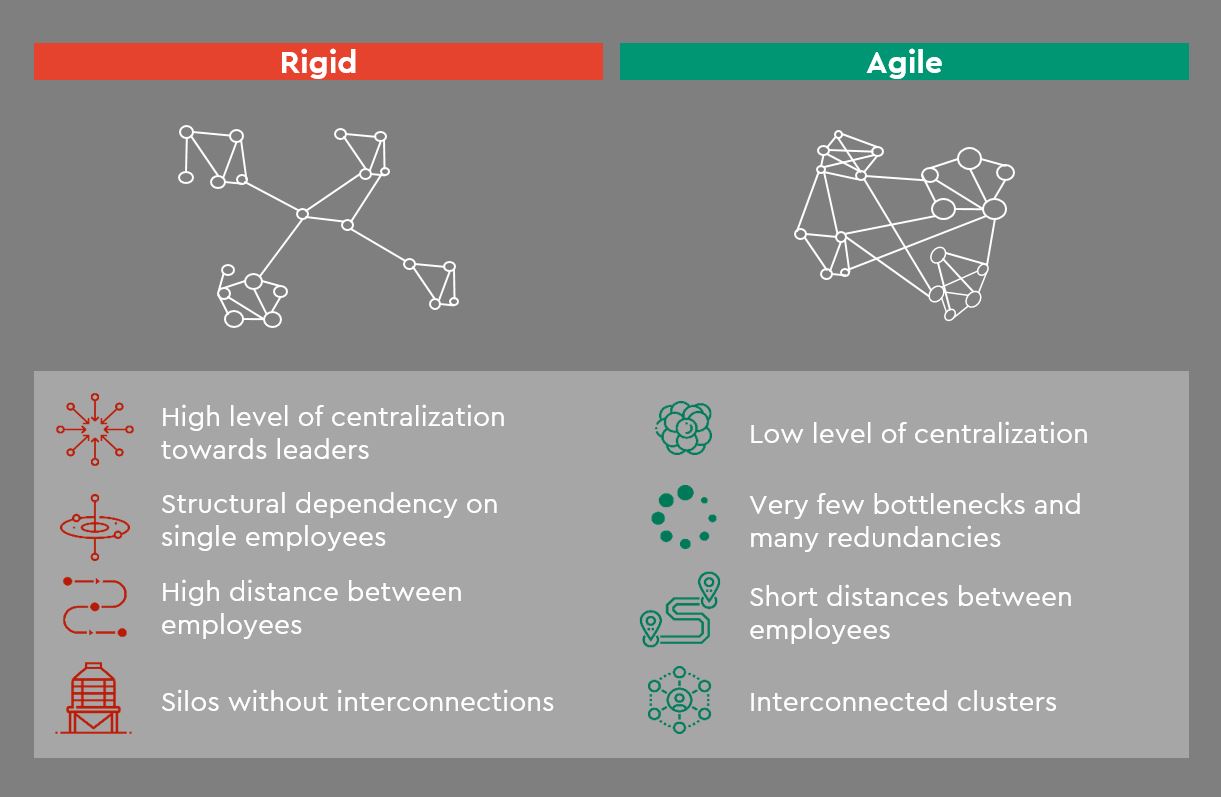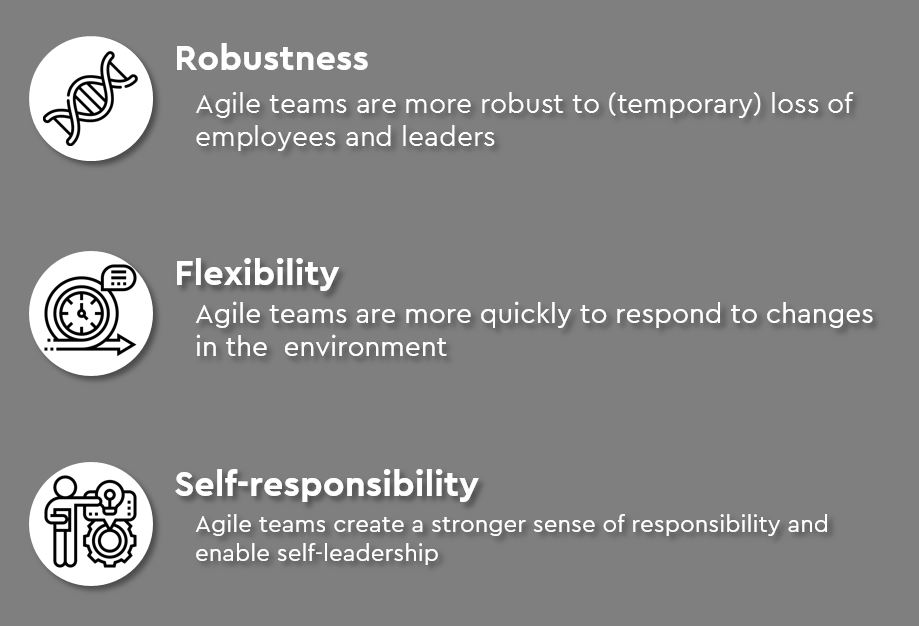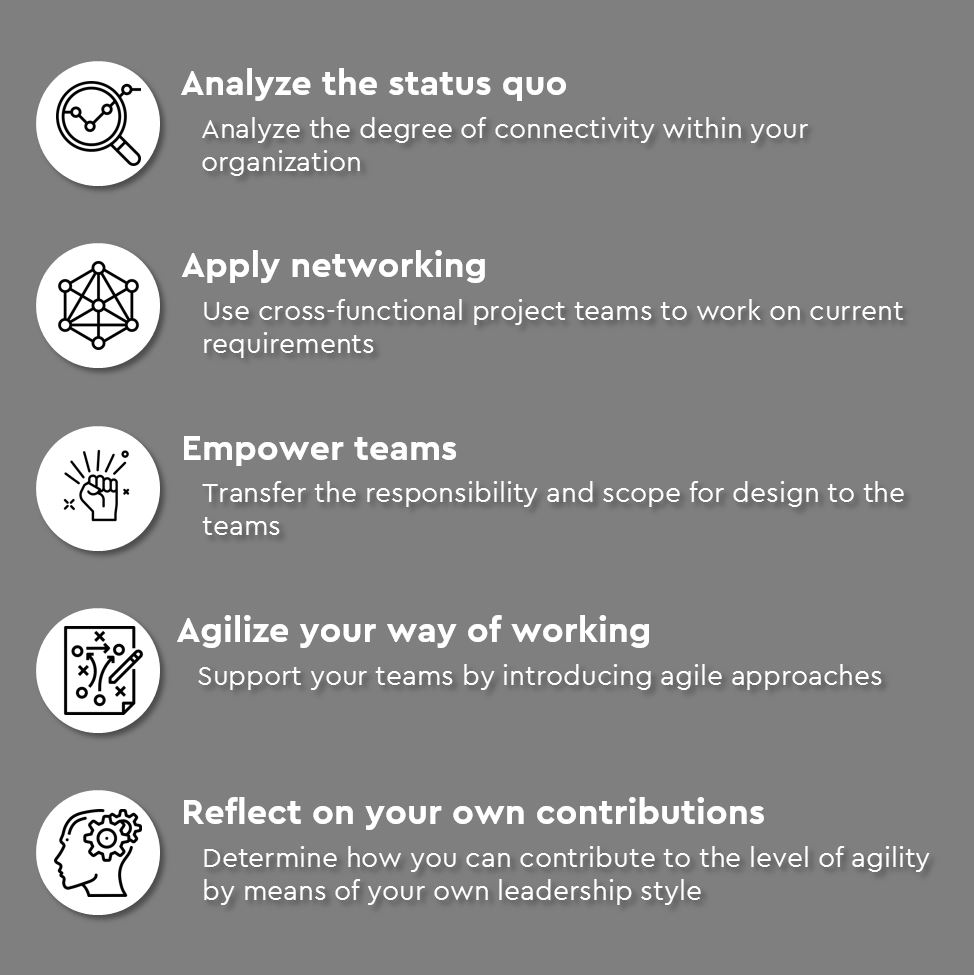
Building agile teams in times of crisis
Enabling agile collaboration requires more than rolling out Slack or Microsoft Teams: Now more than ever, organizations are in need of enabling their workforce and teams to be agile. People Analytics and social network analysis can help. Across the globe millions of white-collar workers are sent home to work remotely. With no ch…


Yannik Leusch
Enabling agile collaboration requires more than rolling out Slack or Microsoft Teams: Now more than ever, organizations are in need of enabling their workforce and teams to be agile. People Analytics and social network analysis can help.
Across the globe millions of white-collar workers are sent home to work remotely. With no change in team structures, leadership, process- and project management, many of those teams are doomed to fail. What works in an office environment becomes impossible within a decentralized, remote working team – especially in times with drastic exogenous influences like COVID-19.
What does an agile team look like?
Findings of social or organizational network analysis can give important insights into what characterizes agile organizations and what factors really matter when trying to build the necessary, more collaborative environment.

First off, agile teams are not centralized around a few nodes (typically leaders), but decentralized. To become successful and maintain productive, teams need to align their structure and tasks to their current manifestation in the physical world: In times of Corona this means a decentralization. Secondly, agile organizations are highly interconnected and can thus faster adapt and activate currently needed paths of collaboration. This short distance between employees also makes it more likely for teams to fill the cultural vacuum that can emerge in teams that are suddenly physically disconnected with a new spirit of collaboration and digital interaction.
Three advantages of agile teams in times of crisis

1) Agile teams are most robust to (temporary) loss of employees and leaders
The robustness of a team or organization can be seen as the vulnerability of the organization to the sudden absence of employees. If a given percentage of the workforce within a network becomes sick or leaves the company the robustness defines whether the network becomes disintegrated and falls into separated pieces. An agile organization is way less endangered of becoming disintegrated than a hierarchical organization.
2) Agile teams are more quickly to respond to changes in the environment
In times of COVID-19 or global trends like digitalization the speed and adaptability of organizations are two of its most important strengths. The ability of agile organizations to quickly adapt, form new connections and change its structure according to the requirements of the new environment might be the strongest advantage over classical hierarchical structures.
3) Agile teams create a stronger sense of responsibility and enable self-leadership
With the majority of white-collar workers now facing the challenge of finding themselves in a completely new situation of remote work in solitude, being part of an agile team allows employees to find ownership and responsibilities in own projects rather than being assigned specific tasks in a bureaucratic and transactional environment. Whereas transactional control reaches its limits in hierarchical structures, agile forms of organization strengthen personal responsibility and establish a culture of ownership for topics and tasks.
Five takeaways for leaders
The introduction or strengthening of agile structures and working methods represents a major change for many organizations. From a multitude of change and transformation projects we know that such a change can only be successful if it is implemented on the levels of organization, team and self. Therefore the following takeaways contribute positively to these three levels.

1) Analyze the networking within your organization (organizational level)
Carry out a network analysis and find out how high the level of internal networking and decentralization is in your organization. If the necessary prerequisites are not met (e.g. missing data and competencies), you can help yourself with a sociogram in the short term. A sociogram is a kind of organizational chart, which focuses on networks and relationships. This is how it works: Draw all relevant organizational units and key persons on a large poster and connect all elements that you think are already well connected. Identify elements that are not sufficiently connected or organizational units where individual nodes stand out. Then mark where stronger networking or improved collaboration is necessary and proactively discuss this observation with the respective persons.
2) Use cross-functional project teams to work on current requirements (organizational level)
The COVID 19 crisis has a drastic effect on daily business and requires an immediate reprioritization of tasks and initiatives. Define what your organization needs to do now to maintain business continuity and adapt to the new business environment. Translate these requirements into specific projects and staff them with cross-functional teams. Rely on the previous network analysis and make sure that the teams are staffed with people from the organizational units whose connection you want to improve.
3) Transfer the responsibility and scope for design to the teams (team level)
Simply define the objectives, requirements and general conditions of the projects. However, leave the team the freedom to decide independently which specific tasks they derive from this and how they work through them. The pull principle, according to which the team members choose their tasks instead of being assigned to them, strengthens self-responsibility and commitment and thus has a positive effect on team performance. Concentrate on providing the necessary resources and removing obstacles.
4) Support your teams by introducing agile approaches (team level)
Focus on elements that promote networking, transparency and self-responsibility. Networking can be promoted by introducing regular meeting formats (e.g. daily stand-ups or retrospectives) and digital collaboration tools (e.g. MS Teams, Slack). Create transparency by using digital to-do lists (e.g. according to Kanban logic) and by introducing roles (e.g. product owner, team coach), through which responsibilities are transparently defined. Encourage self-responsibility by introducing a sprint logic, according to which the teams commit themselves to completing specific tasks within the sprint and present the results in the review meeting.
5) Consider what you can personally improve (self level)
Reflect self-critically on how you need to change your attitudes and leadership styles in order to make the greatest possible contribution to strengthening the agility and networking of your organization. For example, question the extent to which you yourself represent an agile mindset. How easy is it for you to hand over responsibility and fully trust the teams to handle business-critical projects independently? To what extent do you tend to delegate tasks and intervene in a controlling manner? Also consider which people you can get in touch with yourself to proactively increase internal networking.
Although the Corona crisis makes the advantages of agile forms of cooperation and the necessity of implementing agile organizational structures transparent, they also have a general validity beyond the current crisis. If organizations want to remain capable of acting in times of disruptive change through digitalization, the transformation towards more agile structures is essential. The organizational changes in the world of work that Corona has initiated will therefore certainly survive the time of crisis.
For further information feel free to contact our experts:
- Yannik Leusch, yannik.leusch@kienbaum.de, +49 30 88 01 98-49
- Florian Schnitzler, florian.schnitzler@kienbaum.de, +49 30 88 01 98-74
